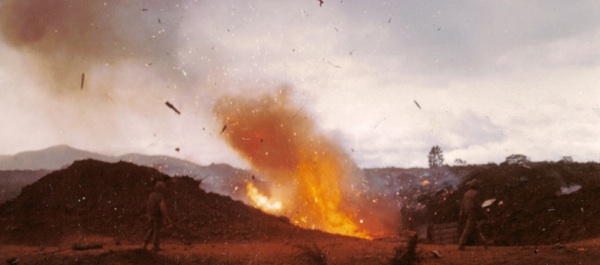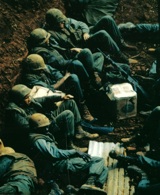Surviving the Siege of Khe Sanh

It was Jan. 21, 1968, and the sun was setting over the hills of Vietnam. All was serene for a group of Marines.
“I was sitting in a bunker with the command group, which consisted of our corpsman, gunny, first sergeant, radioman and others,” said retired Col. Richard D. Camp, Jr., who was the company commander of Company L, 3rd Battalion, 26th Marine Regiment, and a captain at the time. “We were talking about home and holidays. As we were sitting there talking, I suddenly heard ‘boom boom boom.’ I knew exactly what it was – incoming artillery.”
{default}Leading his Marines and setting the example, Camp took action.
“I’m proud to say I beat every one of those troopers to the bottom of that trench, and they all landed on top of me,” Camp said with a smile. “That was the start, as far as I was concerned, of the siege of Khe Sanh.”
Today marks 42nd anniversary of the 77-day battle where Marines outlasted the North Vietnamese Army during the Vietnam War and proved the effectiveness of close air support, according to Shawn P. Callahan’s book Close Air Support and the Battle of Khe Sanh (U.S. Marine Corps, 2009).
Camp and his Marines, along with the rest of the regiment, were abruptly introduced to the North Vietnamese’s firepower that day. Two divisions of the North Vietnamese Army had surrounded the Marines. That was all part of the plan of Army Gen. William Westmoreland’s, the American commander in Vietnam, to draw the North Vietnamese Army away from the cities, so the American’s could destroy them with air power.
“The Marines were charged with defending the Khe Sanh Combat Base,” Camp said, “which was little more than an air strip and a few hill outposts in the northwestern sector of South Vietnam. Camp’s men were charged with defending the northwestern-most perimeter, where the supply drop zone was. There, they worked tirelessly to improve their defenses.
“We were constantly improving our position every day,” Camp said. “We were digging every day and everybody filled sand bags. It became a routine. Eventually you could literally go from the company command to each platoon underground through the trenches and then from platoon to platoon underground along the perimeter. We were always trying to find ways to improve our defenses. Everybody stole everything up there, but it was a good kind of steal. We were stealing barbed wire, concertina wire. We put in cattle fences to direct the enemy’s assault if their infantry attacked. We bribed the engineers to put in mines. I convinced the artillery to loan me five of their .50 cal. machine guns.”
No matter how much they stocked their defenses, they couldn’t stop all of the North Vietnamese shells.
“On that first day we had two casualties,” Camp said. “One of the men was sitting on the edge of the trench and a round took his head off. The second guy, further back, took a piece of shrapnel to the eye.”
Just as the Marines were improving their position, the North Vietnamese were constantly digging as well. The only difference in the two sides was that the Marines could predict their enemy’s movements.
“As officers, we were given the book ‘Hell in a Very Small Place’ by Bernard Fall. It’s about the siege at Dien Bien Phu, [a siege during the Indo-China War where the Viet Minh surrounded and defeated the French in 1954] and the North Vietnamese were copying the battle plan almost exactly,” said Camp. “You could literally turn the page of the book and see what the North Vietnamese were doing. But everyday they got closer despite all of our bombardment—aviation and artillery. Eventually we thought we would have to face an assault by the North Vietnamese. And that’s why we were beefing up our lines. But they could never get that close.
“The thing about Khe Sanh is that it was won by air power.”
“[There was] an average of about five tons of bombs for every North Vietnamese Army attacker,” according to Close Air Support and the Battle for Khe Sanh.
“There was not a moment of daylight when there was not an aircraft rolling in and rolling off the target,” Camp said. “I’ve heard a story where they had [planes] stacked 30,000 to 40,000 feet. They were just waiting to come in, because there was only so much airspace. They would roll in, pull off and then another one would come, literally one right after the other.
“A ways outside the combat base was this triple-canopy jungle in the valleys with tons of towering trees,” Camp said. “When the siege ended there was not a tree standing for miles. I mean, that’s what air power can do. The [Air Force] averaged nine Arc Light strikes per day, which is a B-52 loaded with several 500-pound bombs. They would come in with nine aircraft at a time. You would never hear them coming and then all of a sudden the ground would shake, and you would hear a roar. It was estimated that over 20,000 North Vietnamese were killed during the siege.”
Khe Sanh being on a plateau meant that there was far less humidity than by the coast, Camp said. Even without the heat, however, the weather did factor in.
 “Most mornings there would be this heavy fog,” Camp said. “You couldn’t see someone standing a few feet away from you. It was good in a sense that the North Vietnamese observers couldn’t see so we couldn’t get shelled. It was during that time that we did all of our hygiene things like shave. Then, once the fog cleared off, we would get shelled again.”
“Most mornings there would be this heavy fog,” Camp said. “You couldn’t see someone standing a few feet away from you. It was good in a sense that the North Vietnamese observers couldn’t see so we couldn’t get shelled. It was during that time that we did all of our hygiene things like shave. Then, once the fog cleared off, we would get shelled again.”
Though under siege, the Marines had enough food to survive.
“We were on C-Rations for 70 days, so it got a little old,” Camp said. “We had two C-Rations a day. We had enough water. We couldn’t shower, but we had enough to drink. But then our cook got the Seabees to build these deep bunkers, and he got these huge trees to put over the bunker. Then they covered the top of them and made a fire to make an oven. From then on, once a week he would bring all the mess guys down and they would bake cookies. So, once a week every man was handed a cookie. It was just great for morale.”
Cookies helped the Marines forget their worries for a moment, said Camp.
But treats couldn’t stop the heart-pounding fear of a near-death experience.
“Later, when I was rotated back to the command, we had convinced the Seabees to dig us a pit, “Camp said. “We stole runway matting and put it over the top of our bunker and then we put crushed rocks, dirt and used artillery shells on top so we had a roof six- to eight-feet deep. We were on the edge of a grove of trees, so we put up a two-inch plywood about five feet over the roof. The plywood held a camouflage net on it.
“One morning I was handing one of the guys his C-Ration cup of coffee,” said Camp, "when all of a sudden the radio called, ‘arti arti arti.’ I remember thinking, ‘I wonder where that son of b*tch is going to hit?’ The next thing I knew, the lights go out and the bunker air fills with this real heavy dirt. And there’s this pregnant pause. It’s dark as pitch.
“We had taken a direct hit from a North Vietnamese 120mm artillery piece. It was an instantaneous fuse, so fortunately, when it came through the trees, it hit that plywood and exploded and took out about three feet of our overhead. If we hadn’t had that plywood we would have taken a hit right on the roof and it would have killed everyone. “
To prevent such surprise incomings, dogs were used at the beginning of the siege.
“They had dogs on the line,” Camp said. “You always felt good when you had dogs because their senses are great. But after a while the dogs lost it. They had to evacuate the dogs [because] they had gotten all this tension from their handlers and other Marines, plus from the bombardment. They just started crapping and howling all over the place.”
After 77 days the siege was over on April 8, 1968.
“We didn’t get out of there until the first of May,” Camp said. “Our battalion attacked the hills. By this time the air [attack] had pretty much wiped out the North Vietnamese, and they had pulled back to Laos. But there was still some infantry fighting. When it was all over they closed the base down and destroyed the runway and old ammunition. The regiment pulled out and joined with 1st Marine Division with Operation Meade River.”
Though two different places with two different circumstances, the Vietnam War and the current conflict in Afghanistan share similarities.
 “It was tough because the North Vietnamese could go across the border to Laos,” Camp said. “They had ability to rest and refit just like the Taliban can when they go from Afghanistan to Pakistan. That’s why we’re trying to get Pakistanis to beat them up.”
“It was tough because the North Vietnamese could go across the border to Laos,” Camp said. “They had ability to rest and refit just like the Taliban can when they go from Afghanistan to Pakistan. That’s why we’re trying to get Pakistanis to beat them up.”
Khe Sanh was a tactical victory for the United States, but when Americans saw headlines reading: “Marines surrounded at Khe Sanh” and other stories of the Tet Offensive, the people had had enough, Camp said.
Camp put into perspective the gravity of the situation.
“In 1967 the Marine Corps lost 5,000 Marines in action,” Camp said. “Just in September of that year we had 1,000 casualties. Can you imagine in the news today if it came up that we lost 5,000 Marines last year in Iraq or Afghanistan, what do you think would happen?”
“Khe Sanh was a test of Marines endurance and showcased United States air power,” according to Close Air Support and the Battle of Khe Sanh. “It was looked upon as a golden example and paved the way for future Marine Corps aviation.”
Lance Cpl. Jahn R. Kuiper was born and raised in Gretna, Nebraska. He enlisted in the Marine Corps in June of 2008. After completing Recruit Training and Marine Combat Training in Camp Pendleton I completed the Basic Public Affairs-Specialist Course at the Defense Information School in February 2009. Currently he is stationed at Marine Corps Base Quantico, Va., working as a combat correspondent for the base newspaper, the Quantico Sentry.

